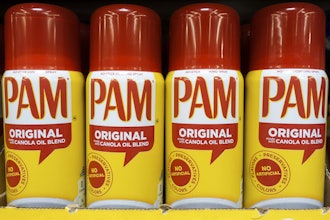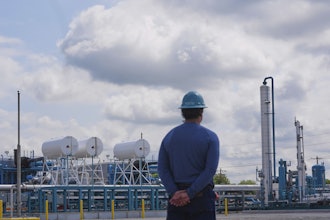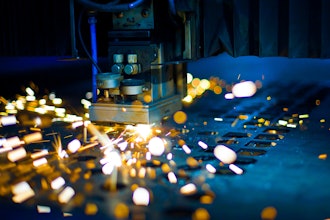The word “titanium” is rarely uttered in the pump world. Yet, titanium offers unique opportunities for many industrial applications. Among them are:
• Elevated strength-to-density ratio
• Low density – roughly half the weight of steel, nickel and copper alloys, which translates into significantly improved rotor dynamics of the titanium rotors
• Exceptional corrosion resistance – superior for chlorides, seawater, sour and oxidizing acidic media
• Excellent elevated temperature properties (up to 600°F)
• Excellent properties at low temperature. ASME allows usage of Titanium Grade 1 and Grade 2 to –75°F
In the past, more wider applicational opportunities of titanium have been restricted primarily due to high cost. However, advances in technology and manufacturing processes have now made significant strides in reducing the cost, thus making titanium an excellent material of choice of numerous applications.
When comparing chemical resistance of metal alloys, four metals usually stand out in the crowd: 316SS, C-20, Hastelloy and titanium. According to the “Fybroc Chemical Resistance Guide, Application Data,” titanium, (the only one with an “A” rating), outperforms all the others above for such chemicals as Adiptic Acid, Ammonium Bicarbonate, Ammonium Carbonite, Ammonium Citrate, Aniline, Arsenic Acid, Arsenous Acid, Barium Sulfide, Butyl Benzyl Phthalate, Butylene Glycol, Calcium Carbonate, Calcium Hypochlorite, Calcium Nitrate, Calcium Sulfate, Calcium Sulfite, Chlorine Dioxide, Chlorine Water, Chloroacetic Acid, Chloroform, Cobalt Citrate, Dichloroethylene, Diphenyl Oxide, Ferric Chloride, Ferrous Chloride, Fertilizer Urea Ammonium Nitrate Composition, Gluconic Acid, Hydriodic Acid, Hydrobromic Acid, Iron Plating Solution, Lithium Carbonate, Lithium Hypochlorite, Magnesium Bisulfite, Magnesium Phosphate, Methyl Ethyl Ketone (MEK), Methyl Isobutyl Ketone (MIBK), Nickel Nitrate, Perchloric Acid, Peroxide Bleach, Potassium Bicarbonate, Potassium Bromide, Potassium Dichromate, Potassium Ferricyanide, Potassium Permanganate, Potassium Sulfate, Propionic Acid, Propylene Glycol, Silver Nitrate, Sodium Bromide, Sodium Chlorate, Sodium Chloride, Sodium Hypochlorite, Styrene Acrylic Emulsion, Sulfur for Fungicides, Tartaric Acid, Titanium Tetrochloride, Urea.
For the following, titanium is the only choice. Others rated as outright unacceptable were: Bromine Wet Gas, Concentrated Ferric Chloride, Wet Gas Hydrogen Bromide, Sodium Chlorite, Uran Fertilizer Urea Ammonium Nitrite Composition, Urea Ammonia Water Nitrate.
“Machinery Handbook” (23rd Edition, page 607) states: “Titanium is outstanding in its resistance to strongly oxidizing acids, aqueous chloride solutions, moist chlorine gas, sodium hypochlorite, and seawater and brine solutions. Its uses in aircraft engine compressors and in airframe structures are based on both its high corrosion resistance and high strength to weight ratio.”
“Materials Selection for Hydrocarbon and Chemical Plant” (David Hansen, Robert Puyear) says: “Titanium (melting point: 3034°F), is a reactive, refractory metal. The most common use of titanium and its alloys in the hydrocarbon and chemical process industries is in heat transfer applications. It is resistant to a wide range of range of both organic and inorganic corrodents. It finds relatively widespread acceptance as heat exchanger tubing for corrosive processes on one side and corrosive cooling water such as seawater on the other side. Titanium is also commonly used for wet chlorine and for concentrated hot caustic solutions. Titanium usage is becoming more common as it becomes more cost competitive with conventional corrosion resistant alloys such as the 300-series stainless steels. Titanium can be useful in mildly reducing applications such as wet alkaline sour overhead condensing systems, if they are properly designed and fabricated. However, titanium (and the other reactive and refractory metals) can be unstable in strongly reducing environments. Selection should be based on experience or should be justified by a testing program. Titanium can become unstable in the presence of powerful oxidizers. Examples include dry chlorine, red fuming nitric acid and liquid oxygen. In addition, titanium can be embrittled by the formation of hydrides.”
A zero corrosion allowance can be specified for titanium, resulting in lower wall thickness. This, coupled with the adequate mechanical strength permits titanium tubing to be used with unusually thin walls.
Corrosion resistance is not the only strength. Titanium also has the extraordinary erosion resistance, about 20 times better then Cu-Ni alloys. Coefficient of thermal expansion is also low – almost half of stainless steel.
The relative obscurity of titanium in the pump world is due to relatively few applications that would justify the cost. However, with applications becoming more sophisticated and costs of titanium reducing, it may be a worthwhile alternative to consider.
Dr. Lev Nelik, P.E., APICS, President, Pumping Machinery LLC, has 30 years experience with pumps and pumping equipment. He is a Registered Professional Engineer, with over 50 publications on pumps and related pumping equipment. He teaches pump training courses in the US and worldwide, and consults on pumps operations and troubleshooting, engineering aspects of centrifugal and positive displacement pumps, maintenance methods to improve reliability, improve energy savings, and optimize pump-to-system operation.






















